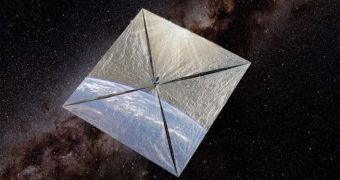The Planetary Society has again announced plans of testing a solar sail prototype, which it hopes to have built in a spacecraft, and then launched by the end of next year. The mission would essentially attempt to harness the power of solar winds for propulsion, a feat that has been advertised for a long time, but that has until now eluded accomplishment. The efforts were again made possible by the fact that the Pasadena, Calif.-based organization received a $1-million anonymous donation, which allowed for it to put its scientists back on the case, Space reports.
“This was an enabling donation, there's no doubt. We've been continuing to think and do studies, but we didn't have the funding in place to embark on this project. Now we do,” the Planetary Society Director of Projects, Bruce Betts, said. The organization essentially wants to show that spacecraft without propulsion systems can still fly in orbit or through space, utilizing nothing more than the energy coming in from the Sun. Only, this time, the energy will not power solar panels that would afterwards power up an engine. Rather, the energy will act as a wind, which will be harnessed through a sail-like structure, made from a special type of material.
For the 2010 flight, the Planetary Society aims to launch a spacecraft at an altitude of about 500 miles (800 km) above the Earth, which it considers to be enough for a proof-of-concept. The unmanned spacecraft is called LightSail-1, and scientists with the group believe that the energy of photons coming in from the Sun is more than enough to keep the ship's orbit from decaying. “It is a very short turnaround with a tight schedule. We definitely have a head start because we've been thinking about this for a very long time,” Betts says.
“Carl and I once wrote, 'We have lingered too long on the shores of the cosmic ocean. It's time to set sail for the stars.' We are celebrating his birthday by announcing the maiden voyages of a fleet of ships conceived to fulfill that mythic imperative. I think I know what this would have meant to him,” artist Ann Druyan, the widow of famed astronomer Carl Sagan, also a co-founder of the Planetary Society, says.

 14 DAY TRIAL //
14 DAY TRIAL //